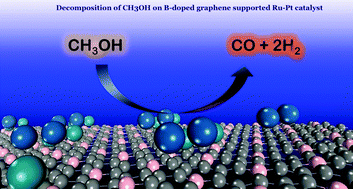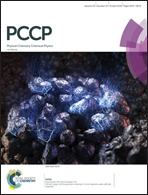Methanol decomposition reactions over a boron-doped graphene supported Ru–Pt catalyst†
Abstract
The decomposition of methanol is currently attracting research attention due to the potential widespread applications of its end products. In this work, density functional theory (DFT) calculations have been performed to investigate the adsorption and decomposition of methanol on a Ru–Pt/boron doped graphene surface. We find that the most favorable reaction pathway is methanol (CH3OH) decomposition through O–H bond breaking to form methoxide (CH3O) as the initial step, followed by further dehydrogenation steps which generate formaldehyde (CH2O), formyl (CHO), and carbon monoxide (CO). The calculations illustrate that CH3OH and CO groups prefer to adsorb at the Ru-top sites, while CH2OH, CH3O, CH2O, CHO, and H2 groups favor the Ru–Pt bridge sites, indicating the preference of Ru atoms to adsorb the active intermediates or species having lone-pair electrons. Based on the results, it is found that the energy barrier for CH3OH decomposition through the initial O–H bond breaking is less than its desorption energy of 0.95 eV, showing that CH3OH prefers to undergo decomposition to CH3O rather than direct desorption. The study provides in-depth theoretical insights into the potentially enhanced catalytic activity of Ru–Pt/boron doped graphene surfaces for methanol decomposition reactions, thereby contributing to the understanding and designing of an efficient catalyst under optimum conditions.



 Please wait while we load your content...
Please wait while we load your content...